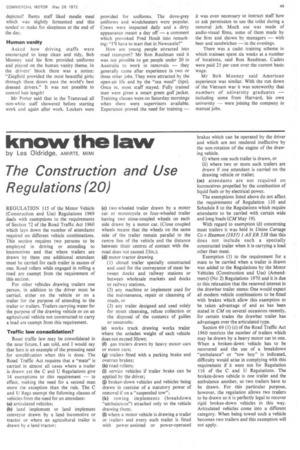know the law
Page 51

If you've noticed an error in this article please click here to report it so we can fix it.
by Les Oldridge, AMIBTE MIMI
The Construction and Use Regulations (20)
REGULATION 115 of the Motor Vehicle (Construction and Use) Regulations 1969 de%als with exemptions to the requirements of Section 72 of the Road Traffic Act 1960 which lays down the number of attendants required on different vehicle combinations. This section requires two persons to be employed in driving or attending to locomotives and that where trailers are drawn by them one additional attendant must be carried for each trailer in excess of one. Road rollers while engaged in rolling a road are exempt from the requirement of this section.
For other vehicles drawing trailers one person, in addition to the driver must be carried, either on the vehicle or on a trailer for the purpose of attending to the trailer or trailers. Trailers carrying water for the purpose of the drawing vehicle or on an agricultural vehicle not constructed to carry a load are exempt from this requirement.
Traffic law consolidation?
Road traffic law may be consolidated in the near future, I am told, and I would say that here is an example of the presssing need for simplification when this is done. The Road Traffic Act requires that a "mate" is carried in almost all cases where a trailer is drawn yet the C and U Regulations give 14 exemptions to this requirement — in effect, making the need for a second man more the exception than the rule. The C and U Regs exempt the following classes of vehicles from the need for an attendant: (a) articulated vehicles; (b) land implement or land implement conveyor drawn by a land locomotive or tractor or where an agricultural trailer is drawn by a land tractor; (c) two-wheeled trailer drawn by a motor car or motorcycle or four-wheeled trailer having two close-coupled wheels on each side drawn by a motor car. (Close coupled wheels means that the wheels on the same side of the trailer remain parallel to the centre line of the vehicle and the distance between thieir centres of contact with the road does not exceed 33in.); (d) motor tractor drawing (1) closed trailer specially constructed and used for the conveyance of meat between docks and railway stations or between wholesale markets and docks or railway stations, (2) any machine or implement used for the maintenance, repair or cleansing of roads, or (3) any trailer designed and used solely for street cleansing, refuse collection or the disposal of the contents of gullies or cesspools; (e) works truck drawing works trailer where the unladen weight of each vehicle does not exceed 30cwt;
(f) gas trailers drawn by heavy motor cars or motor cars;
(g) trailers fitted with a parking brake and overrun brakes; (h) road rollers; (i) service vehicles if trailer brake can be applied by the driver; (j) broken-down vehicles and vehicles being drawn in exercise of a statutory power of removal if on a "suspended tow"; (k) towing implements (breakdown "ambulances") attached only to the vehicle drawing them; (I) where a motor vehicle is drawing a trailer or trailers and every such trailer is fitted with power-assisted or power-operated brakes which can be operated by the driver and which are not rendered ineffective by the non-rotation of the engine of the drawing vehicle.
(i) where one such trailer is drawn, or (ii) where two or more such trailers are drawn if one attendant is carried on the drawing vehicle or trailer;
(m) attendants are not required On locomotives propelled by the combustion of liquid fuels or by electrical power.
The exemptions listed above do not affect the requirements of Regulation 110 and Schedule 8 to the Regulations which require attendants to be carried with certain wide and long loads (CM May 19).
With regard to exemption (d) concerning meat trailers it was held in Union Cartage Co v Heamon (1937) 1 All ER 538 that this
• does not include such a specially constructed trailer when it is carrying a load other than meat.
Exemption (1) to the requirement for a mate to be carried when a trailer is drawn was added to the Regulations by the Motor Vehicles (Construction and Use) (Amendment) (No 2) Regulations 1970 and it is due to this relaxation that the renewed interest in the drawbar trailer stems: One would expect all modern vehicle combinations to be fitted with brakes which allow this exemption to be taken advantage of and as has been stated in CM on several occasions recently, for certain trades the drawbar trailer has advantages over the articulated type.
Section 69 (1) (c) of the Road Traffic Act 1960 restricts the number of trailers which may be drawn by a heavy motor car to one. When a broken-down vehicle has to be recovered and the use of a breakdown "ambulance" or "tow boy" is indicated, difficulty would arise in complying with this requirement if it were not for Regulation 116 of the C and U Regulations. The broken-down vehicle is one trailer and the ambulance another, so two trailers have to be drawn. For this particular purpose, however, the regulation allows two trailers to be drawn so it is perfectly legal to recover rigid broken-down vehicles in this way. Articulated vehicles come into a different category. When being towed such a vehicle becomes two trailers and this exemption will not apply.




































































































